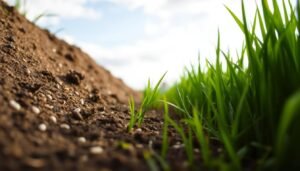I’m thrilled to share the world of hoya plants with you. These tropical wonders are gaining popularity fast. They belong to the Apocynaceae family and are known for their waxy leaves and fragrant flowers. Hoya plants add a unique charm to any room, making them perfect for indoor gardens1.
They’re great for both experienced and new plant owners. Hoya plants bring a touch of tropical beauty to your home without much fuss.
Hoya plants come in over 200 species and varieties. Each one has its own special look1. You can find everything from the popular Hoya carnosa to the dramatic Hoya linearis. They’re all easy to care for and look amazing in any space2.
Key Takeaways
- Hoya plants, also known as wax plants or porcelain flowers, are tropical houseplants that belong to the Apocynaceae family.
- Hoya plants are known for their waxy, deep green foliage and captivating star-shaped blooms with a sweet, honey-like fragrance.
- There are over 200 different species and varieties of hoya plants, each with unique characteristics.
- Hoya plants are relatively low-maintenance and easy to care for, making them an excellent choice for plant enthusiasts of all levels.
- Hoya plants can be propagated easily and are resilient, adding to their appeal as houseplants.
Table of Contents
What is a Hoya Plant?
Origins and Classification
Hoya plants are amazing tropical plants that have been loved by many for a long time. They grow in the warm areas of Asia, Australia, and the Pacific Islands3. These plants belong to the Apocynaceae family, which also includes dogbanes and milkweeds3. The first hoya was named in 1810, and today, there are over 500 names for them. Experts think there are between 600-700 different types, with many still unknown3.
Varieties and Species
Hoya plants come in a wide range of types, with most found in warm parts of Asia3. The well-known Hoya carnosa is just one of many interesting varieties. There’s also Hoya carnosa ‘Krimson Queen,’ Hoya kerri, and Hoya obovata, among others3. These plants can grow in different ways and like different amounts of sunlight3.
| Hoya Plant Species | Distinguishing Features |
|---|---|
| Hoya fungii | Glossy, dark green leaves and clusters of waxy, pink or white flowers4 |
| Hoya lacunosa | Small, round, light green leaves and fragrant, white or pink flowers4 |
| Hoya kerrii | Heart-shaped leaves, making it a popular gift for occasions like Valentine’s Day or Mother’s Day, with small clusters of pink or white flowers4 |
| Hoya obovata | Large, round leaves and clusters of white or pale pink flowers4 |
| Hoya globulosa | Native to the Philippines, a climbing plant with elongated, narrow leaves reaching up to 12 inches (30 cm)4 |
| Hoya latifolia | Offers different clones, massive leaves, and clusters of flowers4 |
Captivating Hoya Blooms
Hoya plants are known for their stunning hoya flowers. These flowers grow in umbels, a cluster from the center. They have three parts: the calyx, the corona, and the corolla. These star-shaped hoya flower characteristics come in white, pink, red, and yellow. They also have a sweet, honey-like hoya flower fragrance that fills the air5.
The beauty of hoya flowers makes them popular houseplants. With over 200 species, each has unique features. This variety of hoya flowers is truly impressive5.
Some popular Hoyas include Hoya carnosa, Hoya kerrii, and Hoya linearis. Each has its own foliage and flower characteristics. For example, Hoya ‘Mathilde’ has fragrant, star-shaped flowers6. Hoya Kerrii (Sweetheart Plant) is slow-growing but becomes a charming trailing plant6.
Whether you like the deep red to pink blooms of Hoya Affinis7 or the large, white flowers of Hoya Albiflora7, these flowers are enchanting.

Hoya plants are easy to care for and propagate5. They are a favorite among indoor gardeners. They bring natural beauty and hoya flower fragrance into homes5.
“The unique and intricate beauty of hoya flowers is a significant factor in their growing popularity as houseplants.”
Caring for Your Hoya Plant
Hoya plants are known for their beautiful blooms and lush leaves. They need the right care to thrive. Knowing their specific needs can help them grow well in your home or garden.
Light Requirements
Hoya plants love bright, indirect light. They can handle low light but do best in 1500-2000 foot candles8. Some species can take two hours of direct sunlight, but too much can burn their leaves9. It’s important to find the right light balance for your Hoya.
Watering and Soil Needs
Hoya plants are good at handling drought, needing less water than many plants8. Water them every 14 days in spring and summer8. Let the soil dry out between waterings to avoid root rot.
A good potting mix with grit or perlite ensures drainage and aeration for the roots8. When repotting, choose a slightly larger container to prevent waterlogging.
Temperature and Humidity
Hoya plants prefer warm temperatures, between 68-75°F8. They can handle a wider range but may stop flowering if it gets too cold8. High humidity, at least 60%, is also important for them8.

“Hoya plants are becoming increasingly popular as houseplants, thanks to their captivating blooms and relatively low-maintenance care requirements.”9
Hoya Plant Propagation
Hoya plants are easy to propagate, making them great for those who love plants. The best way is to take hoya plant cuttings with two nodes. Place them in wet sphagnum moss or a water-filled vase10. Once they have strong roots, you can plant them in pots.
They can also be grown from leaf cuttings or by layering. This method creates new plants that are just like the parent11.
For hoya plant rooting, use a mix of Espoma’s organic Cactus Mix, Orchid Mix, and Perlite10. Water them when the soil is almost dry. Feed them every 2-4 weeks with Indoor! Espoma’s liquid fertilizer or Espoma’s organic liquid Orchid food10.

Some popular Hoya varieties for propagation include Hoya carnosa and Hoya multiflora10. Hoya multiflora needs more cactus mix and water. Hoya pachyclada prefers to be mounted and watered often10.
The best way to propagate Hoyas is by taking cuttings with two nodes. Place them in water or moist sphagnum moss until roots form. Then, pot them in the recommended soil mix101112. Spring and summer are the best times to do this12.
“Hoya plants are a joy to propagate, as you can easily create new plants from cuttings and share the love with fellow plant enthusiasts.”
Whether you’re new or experienced with Hoyas, learning to propagate them is rewarding. By following these tips, you can grow your Hoya collection and enjoy their beauty for years.
Hoya Plant Growth Habits
Hoya plants come in many shapes, making them perfect for different places. Some grow up like Hoya australis, while others hang down like Hoya bella. You’ll also find bushy types like Hoya multiflora and others that are a mix of hanging and shrub-like, like Hoya cumingiana13.
Vining and Climbing Hoyas
Some hoya plants love to climb and grow up. They’re great for trellises or moss poles. Hoya carnosa is a fast-growing favorite that can grow up to 20 feet tall14.
Pendant and Bushy Hoyas
On the other hand, some hoyas are perfect for hanging baskets or shelves. Hoya bella has beautiful, trailing vines. Hoya multiflora is bushy and great for small spaces14.
| Hoya Variety | Growth Habit | Key Characteristics |
|---|---|---|
| Hoya australis | Vining and Climbing | Mature size of 12-20 feet, suitable for vertical supports13 |
| Hoya bella | Pendant | Delicate, trailing vines perfect for hanging baskets14 |
| Hoya multiflora | Bushy | Compact, upright growth ideal for tabletop or shelf displays14 |
Knowing about hoya plants’ growth habits helps you pick the right one for your space. Whether you like climbing, hanging, or bushy plants, there’s a hoya for every spot1314.

“Hoya plants are a true delight, offering an array of growth habits that can be tailored to any home or garden. Their versatility is what makes them such beloved houseplants.”
Hoya Plant Common Problems
Hoya plants are easy to care for but can still face common issues15. Overwatering is the main problem, causing yellow or brown leaves and root rot16. It’s the biggest issue for hoya plant owners, making up 90% of problems.
Underwatering, on the other hand, can cause wilting and leaf drop, affecting 7% of plants16. Lack of nutrients can also lead to yellow leaves15. Pests like aphids and mealybugs are common, weakening plants17.
Spider mites can turn leaves yellow and cause them to drop17. Scale insects can also harm plants, causing leaves to yellow and drop17.
15 Hoyas bloom after 5-7 years, needing bright indirect sunlight15. But too much sun can cause sunburn, affecting 5% of plants16.
15 Diseases like Botrytis and root rots are common17. Leaf spot and root rot can harm plants, especially in moist soil16.
15 To solve these problems, monitor water needs and ensure proper drainage15. Water only when the soil is dry to prevent root rots16. Taking cuttings can save a struggling plant16.
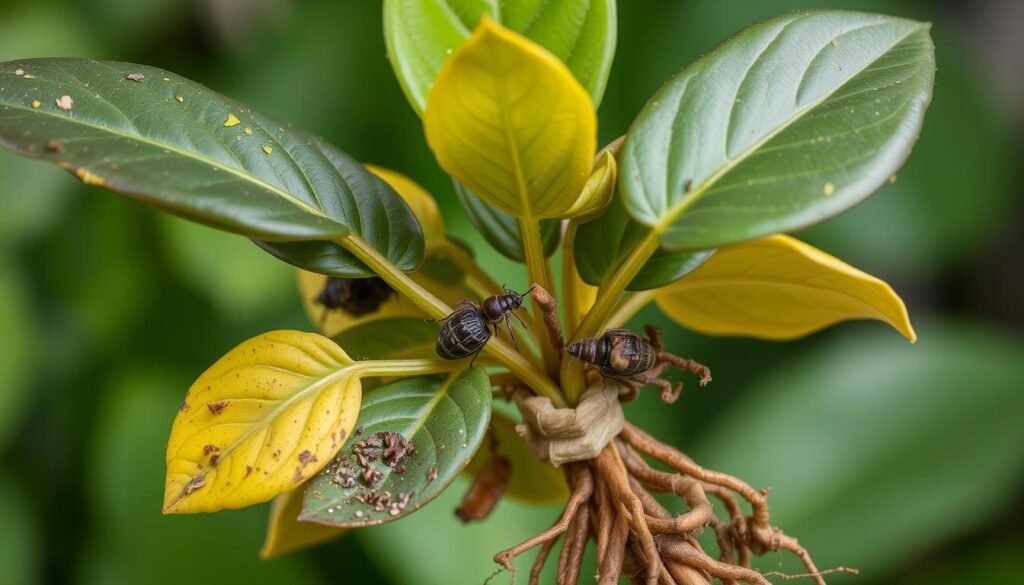
| Common Hoya Plant Problems | Symptoms | Causes | Percentage of Reported Issues |
|---|---|---|---|
| Overwatering | Yellow or brown leaves, soft mushy leaves, root rot | Too much water | 90% |
| Underwatering | Wilting or drooping leaves, brown crispy leaf edges, leaf drop | Insufficient water | 7% |
| Low humidity | Leaves curling or wrinkling, brown crispy edges, brittle leaves | Dry air | 3% |
| Sunburn | Yellow or whitish discoloration on leaves, brown or black leaves, shriveled foliage | Excessive direct sunlight | 5% |
| Pests | Sticky honeydew, white cottony clusters, visible insects on leaves and stems, stippling or discolored areas on leaves | Mealybugs, aphids, spider mites, thrips | 8% |
| Diseases | Soft, mushy leaves or stems, black or brown spots, white fuzzy mold, foul odor | Botrytis, root rots (Pythium, Phytophthora, Rhizoctonia) | 6% |
| Slow growth | Few new leaves, smaller leaf size, leggy growth, lack of new vines | Insufficient light, nutrients, or temperature | 4% |
Encouraging Hoya Plants to Bloom
Hoya plants add beauty to any indoor garden with their stunning blooms. But, getting them to flower can be tricky. Knowing the right care can help you enjoy their blooms18.
First, hoya plants need lots of sunlight to bloom. They love bright, indirect light, sometimes up to 12-16 hours a day18. It’s also important to water them when the top soil feels dry. Keeping the humidity around 40%-60% helps too18.
Good soil and fertilization are also key. Use a mix that drains well and is rich in nutrients19. When buds appear, use a high-phosphorus fertilizer to help them bloom18.
Pruning and regular care also help. Remove dead parts to encourage new growth and blooms18. Leave the stem from the last flowers to get blooms again next year19.
Be patient and keep caring for your hoya plants. They may take 2 to 5 years to bloom18. With the right care, you’ll enjoy their beautiful blooms for years.
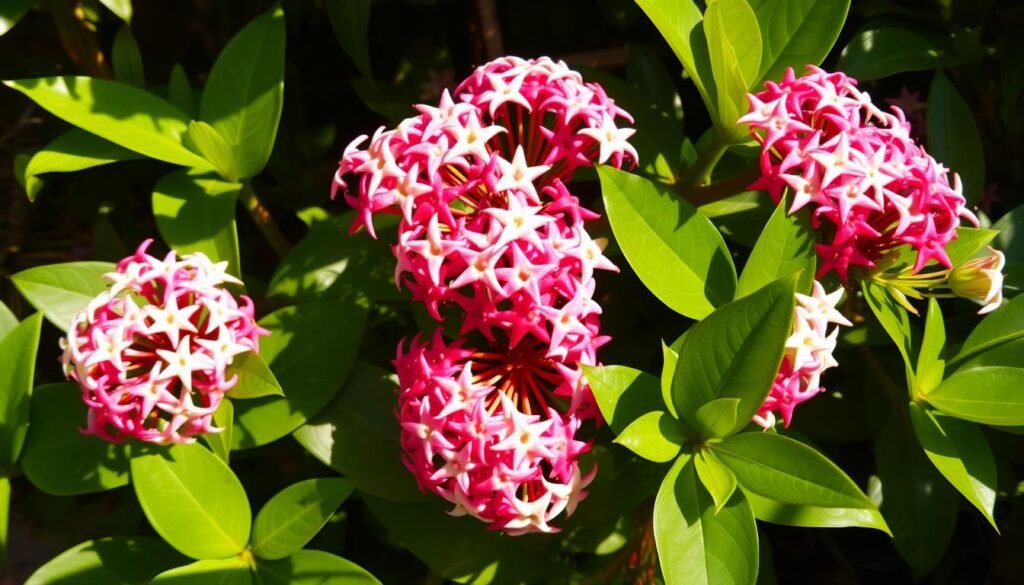
Creative Hoya Plant Display Ideas
Hoya plants are not only beautiful but also highly versatile. They fit well in many settings because of their cascading vines and varied growth habits. Hanging hoya plants in macramé hangers makes for a stunning vertical garden. You can also place them on shelves or mantels, letting their foliage spill over the edges20.
Mixing different hoya varieties, like the heart-shaped Hoya kerrii and the slender Hoya linearis, creates striking arrangements. These arrangements showcase the diverse beauty of these plants20. Adding hoya plants to your indoor decor brings a lush, tropical charm to any space.
- Explore Industrial Corner Plant Stands that can reach up to 67 inches in height, providing a dramatic backdrop for your hoya display20.
- Consider a 3-tier Wooden Indoor Plant Stand with a 16-inch rotating window shelf to ensure your hoya plants receive optimal light exposure20.
- Browse Plant Stands & Tables from retailers like Wayfair to find the perfect furniture pieces to showcase your hoya collection20.
- Opt for Small Square Wooden Wall Planters to create a compact, wall-mounted display for your hoya plants20.
- Invest in an 8-tiered Metal Plant Shelf with a built-in full-spectrum grow light for a stunning and functional hoya display20.
By exploring these creative display ideas, you can transform your hoya plants into captivating focal points. They add a touch of natural beauty to any indoor space20.
“Trellising is crucial for the health and vitality of Hoya plants to promote abundant and beautiful leaves and flowers.”21
Proper trellising allows Hoya plants to grow more efficiently. It keeps them organized and structured, leading to more energy for new leaves and flowers21. Early trellising trains leaves to face upwards for better growth21. Hoyas benefit from trellising to grow towards a light source, making them more attractive21.
Different materials for trellises are available, such as wood, bamboo, or metal. Bamboo is a popular eco-friendly choice21. Copper is recommended for its durability, with coated copper to prevent toxicity to plants21. Proper air circulation is crucial to prevent mold and fungus growth21. Trellising should be done carefully to avoid forcing leaves against the trellis21. Watch for signs of overcrowding, such as sagging vines or yellowing leaves, which may require additional support or a larger trellis21.
By incorporating these creative display ideas and proper trellising techniques, you can elevate the beauty and health of your hoya plants. This creates stunning and visually engaging displays that will captivate any space2021.
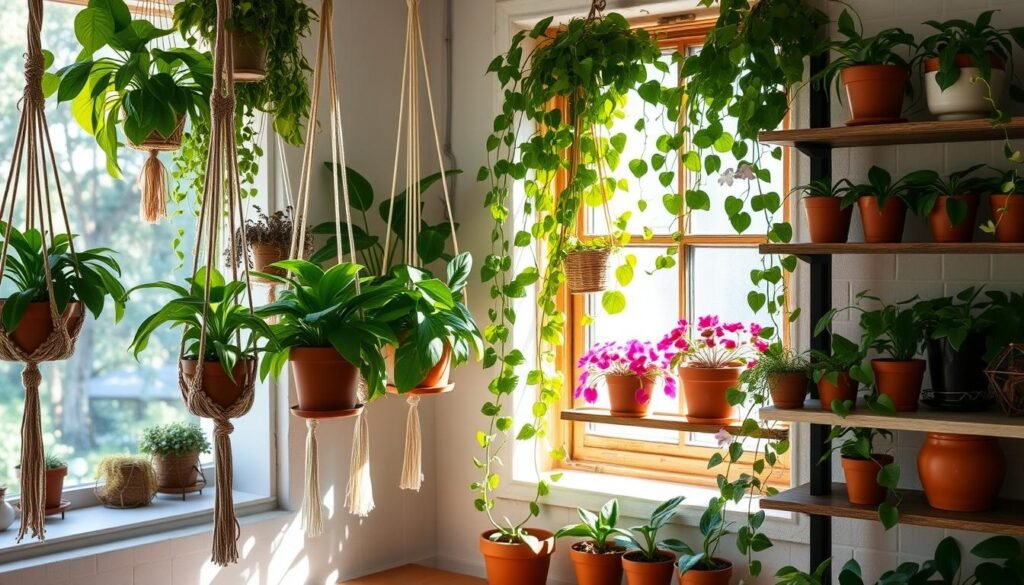
The Timeless Appeal of Hoya Plants
Historical and Cultural Significance
Hoya plants have a special place in many cultures and traditions. They are known for their beautiful blooms and ability to thrive in tough conditions. These plants symbolize love, friendship, and prosperity22.
In some cultures, hoya plants are given as gifts to show love and friendship22. They are seen as symbols of strength and endurance, inspiring people across generations22.
Hoya plants are also believed to bring good luck and symbolize success22. Their waxy leaves are linked to longevity and heritage. They can become family heirlooms, lasting for many years22.
These plants represent continuity, prosperity, and respect for elders in many cultures22. Their appeal has made them popular houseplants, valued for their beauty and cultural significance22.
Whether in a home or at a special event, hoya plants leave a lasting impression22. They are resilient and visually striking, captivating and inspiring everyone who sees them22.
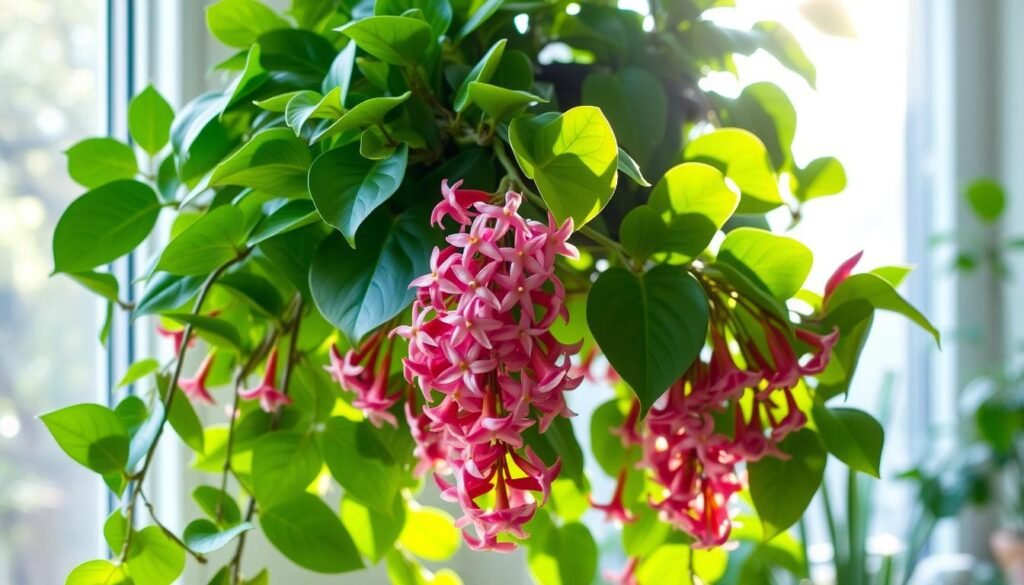
| Hoya Plant Variety | Unique Characteristics |
|---|---|
| Hoya macrophylla | Effective air purifier, thrives in various lighting conditions, low-maintenance, symbolic of prosperity and good luck22 |
| Hoya burtoniae | Variegated leaves, air-purifying properties, low-maintenance, visually appealing foliage and flowers, symbolic of endurance and renewal23 |
| Hoya Australis | Evergreen climbing vine that can grow up to 33 feet tall24 |
| Hoya Lauterbachii | Known as the Giant Wax Plant, features cup-shaped red and yellow blooms up to 3 inches across24 |
| Hoya Brevialata | Features small, pale green oval leaves that bloom with deep pink fragrant flowers24 |
Hoya plants are cherished for their beauty and cultural significance22. They symbolize love and prosperity and purify indoor air. Their adaptability and timeless beauty make them popular worldwide22.
Hoya Plant Care Tips
Pruning and Maintenance
To keep your hoya plant healthy and thriving, regular care and pruning are key25. Hoya carnosa, a popular choice, benefits from occasional pruning. This helps it grow bushier and removes dead leaves26. When you repot, choose a slightly larger container to avoid too much water.
Also, remember to meet the plant’s light, water, and humidity needs. These conditions are vital for its health and flowering.
27 Hoyas can handle about two hours of direct sunlight in the morning or evening26. They prefer bright, indirect light for best growth. Water them with room-temperature water in spring and summer, letting the soil dry a bit between waterings26.
Water less in fall and winter to prevent overwatering and flower drop.
26 Hoyas love humid conditions, especially in winter. Use humidifiers or gravel saucers with water to increase humidity26. They should stay above 60 degrees Fahrenheit all year.
26 Prune your hoya in spring before it grows a lot. Focus on the stems with no leaves (spurs) where flowers grow26. Use Espoma’s Orchid! liquid fertilizer once a month from spring to fall.
By following these tips, your hoya will stay healthy and bloom beautifully for years.
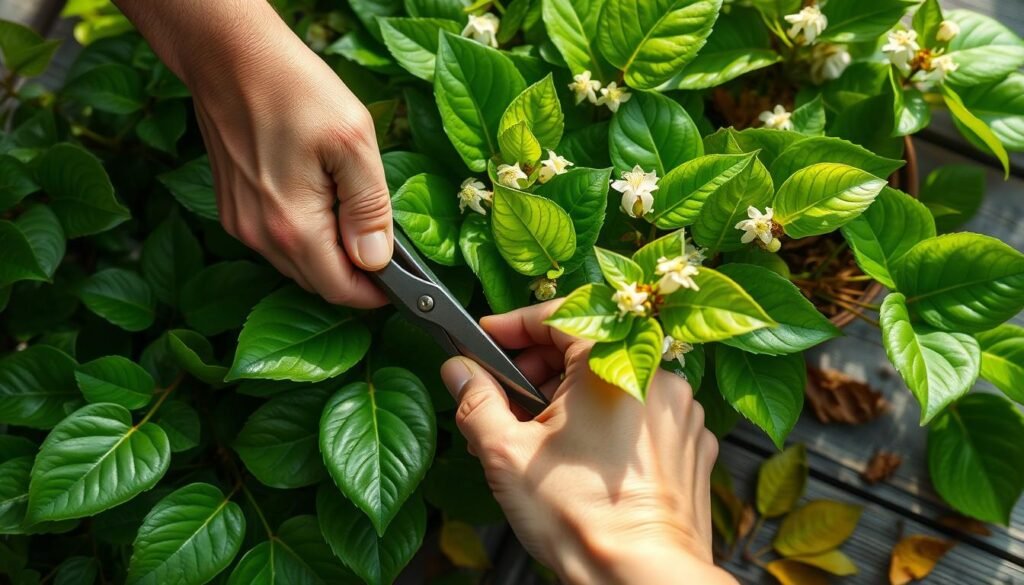
“With the right care and attention, your hoya plant will thrive and bring years of beauty and joy to your indoor garden.”
| Hoya Plant Variety | Unique Features |
|---|---|
| Hoya carnosa ‘Krimson Queen’ and ‘Krimson Princess’ | Variegated forms of Hoya carnosa25 |
| Hoya carnosa ‘Compacta’ | Leaves folded in on themselves, giving it a rope-like appearance25 |
| Hoya linearis | Hangs dramatically with needle-shaped leaves25 |
| Hoya callistophylla | Features bright green lanceolate leaves with dark veins25 |
| Hoya lauterbachii | Grows large blooms and soft, pubescent leaves25 |
| Hoya spartioides | Does not grow any leaves and carries out photosynthesis in its stems25 |
Conclusion
The Hoya plant is a joy for indoor gardeners, blending beauty, toughness, and simple care28. Their elegant vines, waxy leaves, and fragrant flowers win hearts globally2928. Whether you’re an expert or starting out, Hoya plants add tropical charm to your space.
Learning about Hoya plants’ special needs lets you enjoy their beauty for years2930. They need the right light, temperature, water, and soil to flourish2928. Plus, their varied shapes and colors fit well in any display28.
Starting your Hoya plant adventure is rewarding30. These plants live long, grow strong, and bloom beautifully. They’re a true pleasure to grow and admire.


